With an average rainfall of 1,200 cm per year, Meghalaya is known as the wettest region in the world.
Rainy weather can make life and work more difficult and challenging for us. Yet, there are places on Earth where people must live under continuous downpours.
Amos Chapple, a photographer from New Zealand, recently captured a series of photographs in Meghalaya (India) – a land known for its relentless rainfall and recognized as the location of the “wettest place on Earth.”
His images beautifully and authentically document the daily lives of the residents in this unique environment.
About a two-hour taxi ride from Shillong, the capital of Meghalaya, are the Khasi Hills at an altitude of nearly 1,500 meters. There lies the famous village of Mawsynram, officially recognized by Guinness World Records as the “wettest place on Earth.”
The heavy rainfall is caused by summer air currents sweeping across the flooded plains of Bangladesh, gathering moisture as they move north into India. As these clouds descend over the steep hills of Meghalaya, they are “pushed” through the atmosphere and compressed to the point where they can no longer hold their moisture, resulting in almost continuous rain in this village.
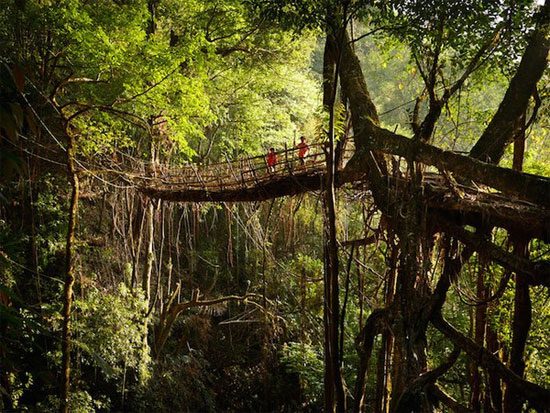
Meghalaya – The wettest place on Earth.
Meghalaya is a state in Northeast India, covering an area of 22,429 km2, with approximately 70% of its territory covered by forests. With over 11,880 mm of rainfall each year, it receives 11 times more rain than Glasgow and 22 times more than London, two cities also known for their wet weather. According to DNA India, the annual rainfall in Mawsynram could submerge the knees of the 30-meter-high Christ the Redeemer statue in Rio de Janeiro. It is truly the wettest place on Earth.
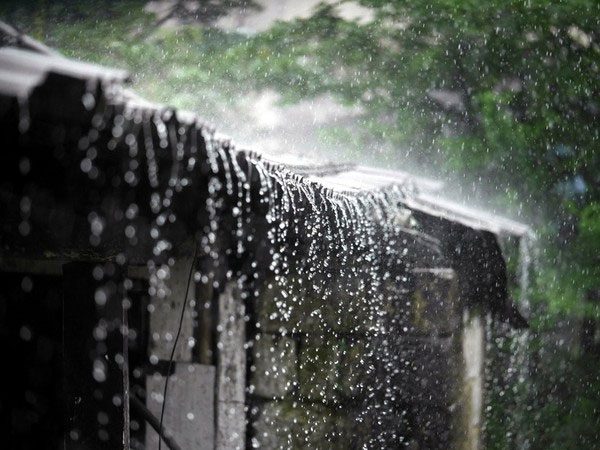
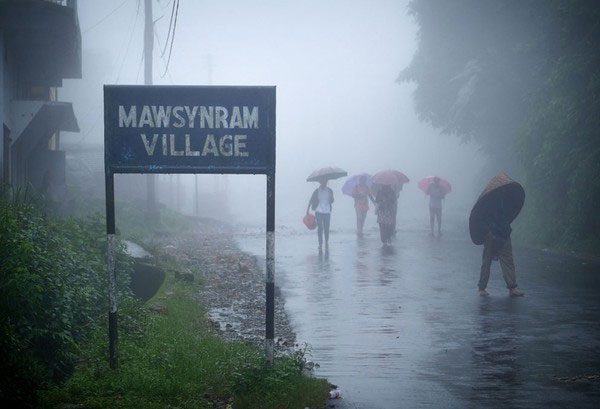
This is home to about 3 million people.
Meghalaya is also home to around 3 million people, primarily belonging to the Khasi ethnic group (about 1.2 million), along with the Garos and Jaintias.
They have lived here for 2,300 years under a matrilineal system. Thus, the people of Meghalaya are often referred to as the “matrilineal tribe.”
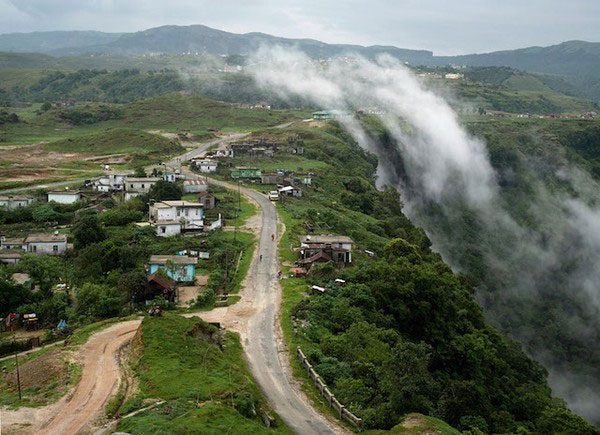
The cause of the heavy rains here is the flow of moist air from the flooded plains of Bangladesh moving northward. As the clouds pass over the high, steep hills of Meghalaya, the temperature drops, causing condensation and continuous rainfall.
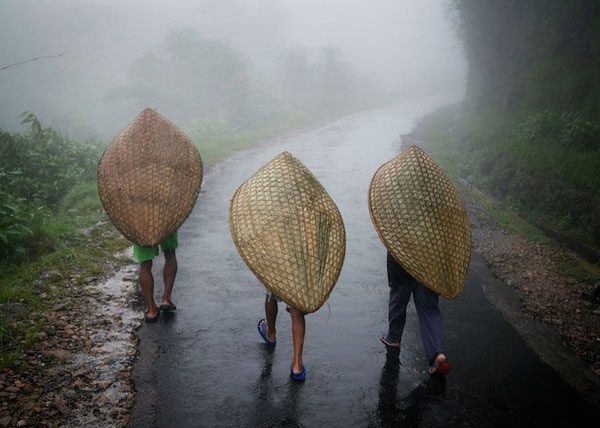
According to descriptions, during the rainy season, the sound of rain is so loud that students cannot hear their teachers’ lectures. To reduce the noise, residents have devised a method of thickly thatching their roofs with grass.
To cope with the persistent rain, the locals have created a type of “raincoat” called Knups, which resembles a boat made from bamboo and banana leaves.
With this unique “raincoat,” they can continue to work normally with both hands free, and the shape of the Knups helps keep them dry even during heavy rain and thunderstorms.
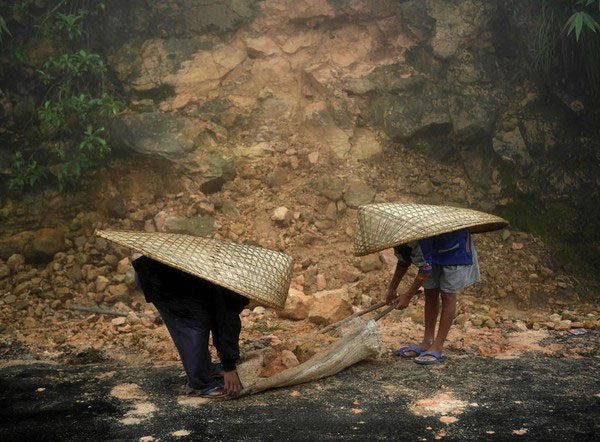
Special raincoat shaped like a boat.
Due to the immense rainfall, this land is always wet and features many waterfalls, along with enchanting limestone caves where vegetation thrives.
The characteristic rainy season in Mawsynram occurs widely. About 90% of the annual rainfall is recorded during this period. The rainy season lasts for half the year, from May to October, with July typically being the wettest month, averaging up to 3,500 mm of rain.
During the peak months of June and July, the rainfall measured in this village can reach around 7,000 mm. With the hilly terrain, landslides are an inevitable concern in Meghalaya.
To keep the roads clear during the rainy season, local authorities hire residents at a wage of $2.50 per day (around 50,000 VND) until the rainy season ends around October.
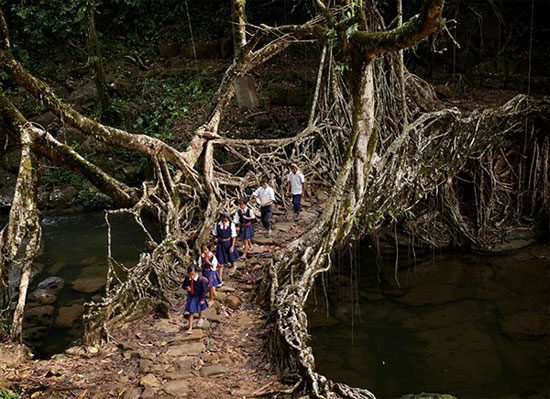
Root bridge crossing the stream.
The bridges in Meghalaya are incredibly unique. Instead of being constructed from concrete like in other places, the locals use the roots of living trees to create bridges across streams.
Roots from fig trees and rubber trees are woven together into bundles. Over the centuries, these roots grow stronger, creating extraordinarily sturdy bridges. These “living” bridges can reach lengths of up to 30 meters and can support the weight of 50 people.
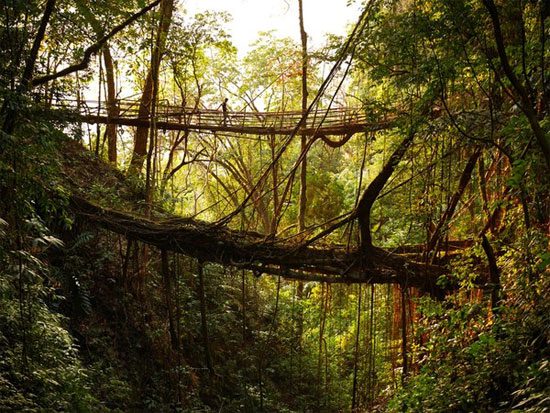
To make these bridges, locals first use bamboo for the framework. Then, they weave the lateral roots of rubber trees onto it, which will grow along that bamboo framework.
After some time, the bamboo frame decays, but the rubber roots continue to grow. According to the locals, it takes about 7 to 8 years to create a bridge strong enough to support a person.
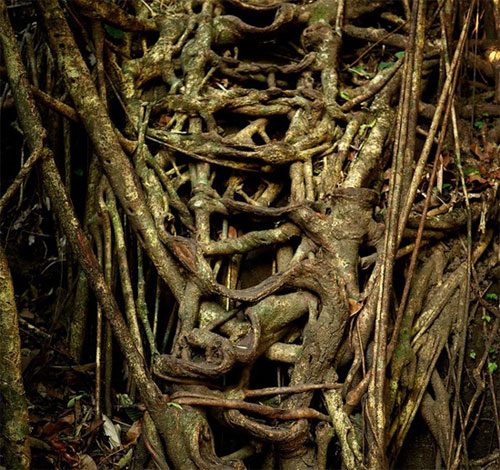
Not only do they use roots to make bridges, but the locals also utilize roots to construct other structures, such as steps leading up steep paths.
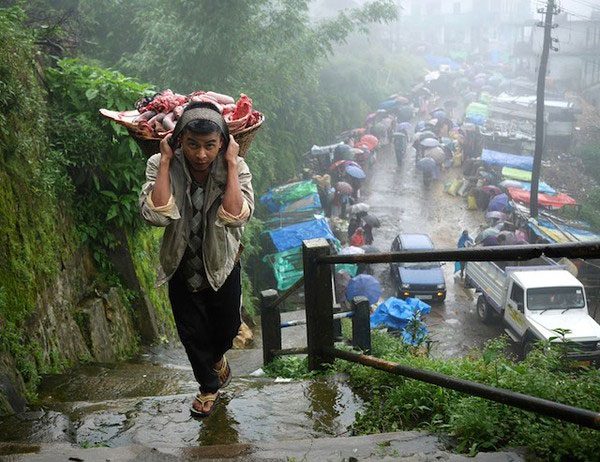
Due to excessive rainfall, farming is nearly impossible. The locals often import vegetables and fruits from drier regions to sell in covered markets.
The life of the residents here remains quite backward; such covered markets provide the main source of food for the villagers.
The heavy, prolonged rains make life challenging for the residents. The downpours often prevent people from going outside, and children cannot attend school. Landslides and floods threaten the livelihoods of the people when heavy rains hit, and power outages can last for days.
Residents in the town complain that living indoors is a torment due to the constant noise of the rain, causing headaches. Sometimes, classes are canceled because students cannot hear their teachers’ lectures. “No place rains like here; we can’t see beyond 1 meter. We can touch, smell, and taste the clouds every day,” one resident stated.
Despite the rain, the lives and work of the locals continue. For them, it is not helpful to dwell on the difficulties brought by the rain, as they must work regardless of the weather.
Although life in Mawsynram faces many obstacles, it is in this wettest place in the world that visitors can witness the sight of swirling clouds against sheer cliffs or clouds “flying straight” into their homes. Some even claim they can almost touch and smell the “scent of clouds” that is unique to this place.
However, the “wettest place on Earth” also experiences drought conditions when the monsoon ends around October. During this time, some reservoirs in the area nearly run dry, and residents receive water for only two hours in the morning and two hours in the evening. They refer to this period as the “water tap war.”


















































